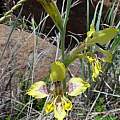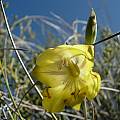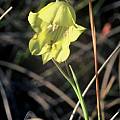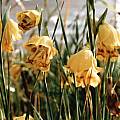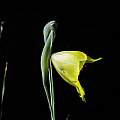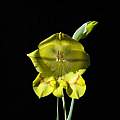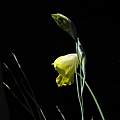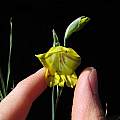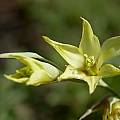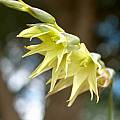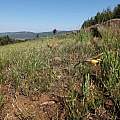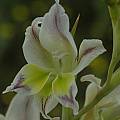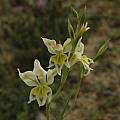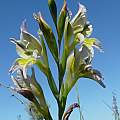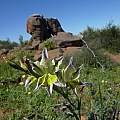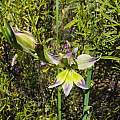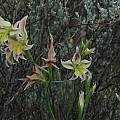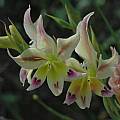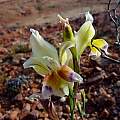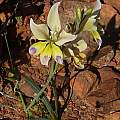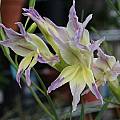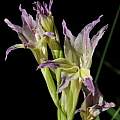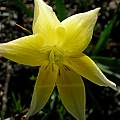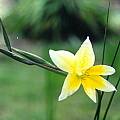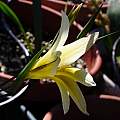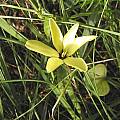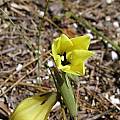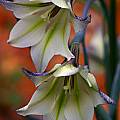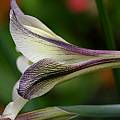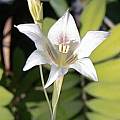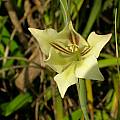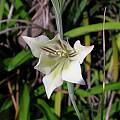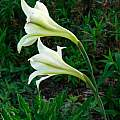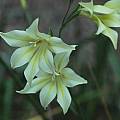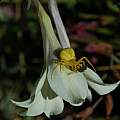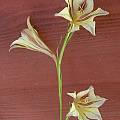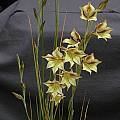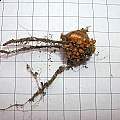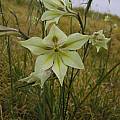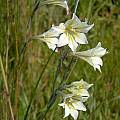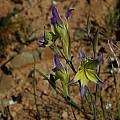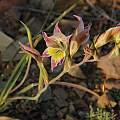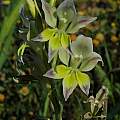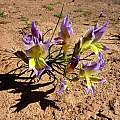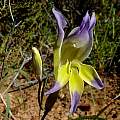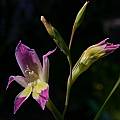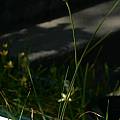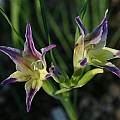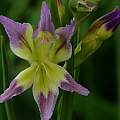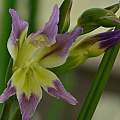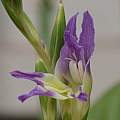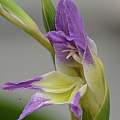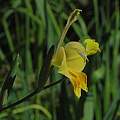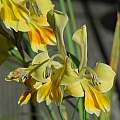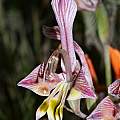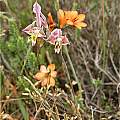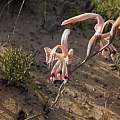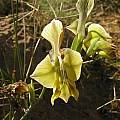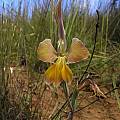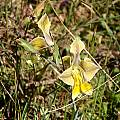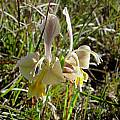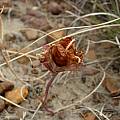Yellow may not be the first color that comes in mind thinking of Gladiolus, but there are some very striking species in this category. Quite often, there is a secondary yellow form of mainly orange or purple Gladiolus species.
Page 1: G. alatus... Page 2: G. comptonii... Page 4: G. woodii...
Gladiolus pardalinus Goldblatt & J.C.Manning is restricted to the bushveld of Northern Province and Mpumalanga, South Africa where it grows in dolerite in rocky ground. Growing from 35 to 55 cm high, it has usually three leaves that sheath and envelope the stem and 10 to 15 flowers in a spike. Flowers are pale yellow speckled with red brown markings on all except the dorsal tepal. All of the tepals are clawed at the base. This species flowers in early spring, mid October and November. Photo from Rachel Saunders.
Gladiolus pritzelii Diels is found on rocky sandstone slopes in the northwest Cape. It has bell-like yellow fowers with red to brown transverse markings on the lower tepals. The first photo was taken by Cameron McMaster on Ouberg Road in the Roggeveld, the second by Rod Saunders from Silverhill Seeds. The flowers have a mild scent of green apples.
The photos below are of plants in cultivation. Photo 1 was from Alan Horstmann and photos 2-5 were taken by Nhu Nguyen.
Gladiolus pubigerus G.J.Lewis syn. Gladiolus pugioniformis has a strange distribution pattern. It is found in the Eastern Cape and in some areas of Natal, and then in the mountains of Mpumalanga. It has pale lemon yellow flowers tinged with green and flowers in spring. The plants in Mpumalanga are a bit different to those in the Eastern Cape. It flowers well after a fire and not as well in between. The first two photos were taken by Cameron McMaster. The last photo was taken by Rachel Saunders September 2014 in habitat in Mpumalanga near Lydenburg, at an altitude of about 1800 m. It was flowering in a fire break around a pine plantation which was burned sometime in the winter. The area had a small amount of rain in August, and this was obviously enough to stimulate a few plants to flower.
Gladiolus scullyi Baker is found on silty clay and granite slopes in the northern winter rainfall areas (Namaqualand and western Karoo). It is very similar to Gladiolus venustus but is less colorful with dull yellow to light brown flowers with darker yellow on the lower tepals and darker brown to purplish highlights. The dorsal tepal is also more horizontal, inclined over the stamens and the upper two lateral tepals curve outward in an arc. It is fragrant and windowed in profile. Photos 1-2 taken by Bob Rutemoeller September 2006 near Nieuwoudtville (photos 1-2). Photos 3-5 taken by Cameron McMaster in various locations near Nieuwoudtville September 2011.
Photos 1-2 taken by Bob Rutemoeller September 2006 in Namaqualand. Photos 3-4 were taken by Cameron McMaster September 2011 near Carolusberg in Namaqualand. The last two photos were taken taken by Bob Werra.
Gladiolus trichonemifolius Ker Gawl. is found on wet sandy flats in the winter rainfall areas. It flowers in late winter to early spring and is cream to yellow with brown lines on the lower tepals and a darker yellow center.
Photos below show the typical form. The first photo by Alan Horstmann, the second by Mary Sue Ittner, and the last two by Michael Mace.
This species now includes a form formerly known as Gladiolus citrinus Klatt, which has a cupped perianth and a dark purple blotch in the center. It's very different from the typical form. The first three photos from Rod Saunders and Bob Rutemoeller show the former Gladiolus citrinus.
Gladiolus tristis L. is one of the more widespread species in the winter rainfall regions. It is often found in dense colonies on damp flats, but can be found near sea level to high elevations. It is nicknamed the marsh Afrikaner and can be found in marshy areas, but also on banks above streams, in poorly drained seeps or on cool south-facing slopes. The time of bloom varies by populations. It produces a lot of little cormlets around the base of the corm and can spread to other pots if soil is reused. This species also spreads by seed, and has been known to naturalize in habitats it likes such as gardens and botanical gardens. It's not a thug, but be aware of what you're doing if you put it in the ground in a mediterranean climate. Plants grow to about 2 feet (~0.7m) tall with slender, spiraling leaves about the diameter of a chopstick. It is easily grown in a well-drained mix, full sun, and summer dry dormancy. Give it a dilute or slow release fertilizer high in phosphorous when in active growth.
Photos 1-2 were taken by Sheila Burrow, 3 by Doug Westfall, 4-5 by Alan Horstmann and 6 by Kathleen Sayce.
I grow two forms. One is light yellow and blooms March to April. It is only slightly fragrant at night. It is the first one pictured below. In the second photo there is a spider on the flowers, catching what seems to be a fly pollinator. The second form pictured below in photos 3-4 is a late blooming form, once known as Gladiolus tristis var. aestivalis, but not recognized as a variety by Goldblatt and Manning. These plants were grown from IBSA seed collected near Paarl where they grow in wet boggy areas that are shady. This form is very fragrant at dusk/night when the flowers are open wider as well. The last photo shows one corm on a 1 cm grid with all the cormlets showing how many new plants are possible from one corm. Photos by Mary Sue Ittner .
Habitat shots taken by Bob Rutemoeller September 2003 at Drayton and Cameron McMaster at Bredasdorp.
Gladiolus venustus G.J.Lewis has flowers that are shades of purple to pink and sometimes dull yellow with yellow markings on the lower half of the lower tepals. It is widely distributed across the interior of the winter rainfall areas of southern Africa where it is found in dry habitats on clay and sandstone slopes. The primary pollinators are long tongued bees. It can be confused with Gladiolus scullyi and it has been included in that species at one time but it usually more colorful than that species which is usually greenish cream to yellow brown or beige and more highly scented. The dorsal tepal on Gladiolus scullyi is also more horizontal, inclined over the stamens and the upper two lateral tepals curve outward in an arc. But the distinctions are sometimes difficult to tell, especially in areas where they both grow. An example of this difficulty is shown in the third picture which I suppose could be either species. The first two photos by Mary Sue Ittner and Bob Rutemoeller were taken September 2006 in the Roggeveld. The third photo from Mary Sue Ittner was taken near Nieuwoudtville. The last two photos were taken by Cameron McMaster September 2011 near Middelpos in the Roggeveld.
Photos below were taken by Bob Werra.
Photos below were taken by Arnold Trachtenberg.
Gladiolus virescens grows on sandstone or clay slopes in a broad area flowering in late winter to spring. Flowers are yellow to pink with dark veins and very fragrant. The first photo shows a pink one grown by Alan Horstmann and photographed by Bob Rutemoeller. The next two photos were taken by Mary Sue Ittner of plants grown from seed. Photos 4 and 5 were taken by Andrew Harvie at the De Hoop Nature Reserve. The last photo was taken by Rachel Saunders of an unusual color form found flowering in December, much later than the usual time.
Two different color forms were photographed in the southwest Cape September 2003 by Bob Rutemoeller. The next three photos taken by Cameron McMaster at Boskloof and near Napier, both in the Overberg. The last picture shows the seed pods.
Page 1: G. alatus... Page 2: G. comptonii... Page 4: G. woodii...
